Summary:
- Bitcoin halving is approaching, and miners are focusing on post-halving breakeven and profitability.
- CleanSpark has shown impressive growth and efficiency in its mining operations, with plans to expand its hashrate.
- CleanSpark’s equity financing and low debt-to-equity ratio makes it an attractive stock, going into Bitcoin post-halving.

da-kuk
The much-anticipated quadrennial Bitcoin (BTC-USD) halving event is just about 2 days away (est. April 20). The primary focus for most miners at this juncture is to ensure post-halving breakeven and eventual profitability, as the impending reduction in block rewards directly impacts their sales.
Acquisitions and purchase of mining equipment and sites are some of the key preparations for post-halving breakeven by miners. At this stage of the market cycle, most investors would prioritize miners with a substantial amount of liquidity for equipment purchases and other acquisitions for post-halving thriving. The liquidity position of mining companies and their operational efficiency are critical components to look at this stage of pre-halving, in my view.
CleanSpark (NASDAQ:CLSK) initially aimed for a hashrate of 22.4 EH/s in 2023, but had to revise it down to 16 EH/s due to delays in expansion plans. However, by the first quarter of 2024, CleanSpark is already close to doubling its end-of-year 2023 hashrate of around 10 EH/s – an impressive turnaround. The company has added about 7 exahashes since the beginning of 2024 and is on track to achieve its target operational hashrate of over 20 EH/s around the Bitcoin halving.
You can have anything you want, but you can’t have everything you want. – Mary Schmich
In running a business tied to a volatile asset like Bitcoin, it is important for teams to be able to control as many variables as possible for efficient capital management. I believe that in this run-up to the Bitcoin halving and the ensuing Bitcoin supply reduction, qualitative factors like management proactiveness and miners’ operational efficiency hold equal weight alongside financial metrics. The crypto market is time-sensitive, and decisions made at each point in the cycle could directly translate to efficient or inefficient capital allocation and either operational gains or losses. That’s why I’m big on management decision-making qualities for Bitcoin mining companies at this phase of the market cycle.
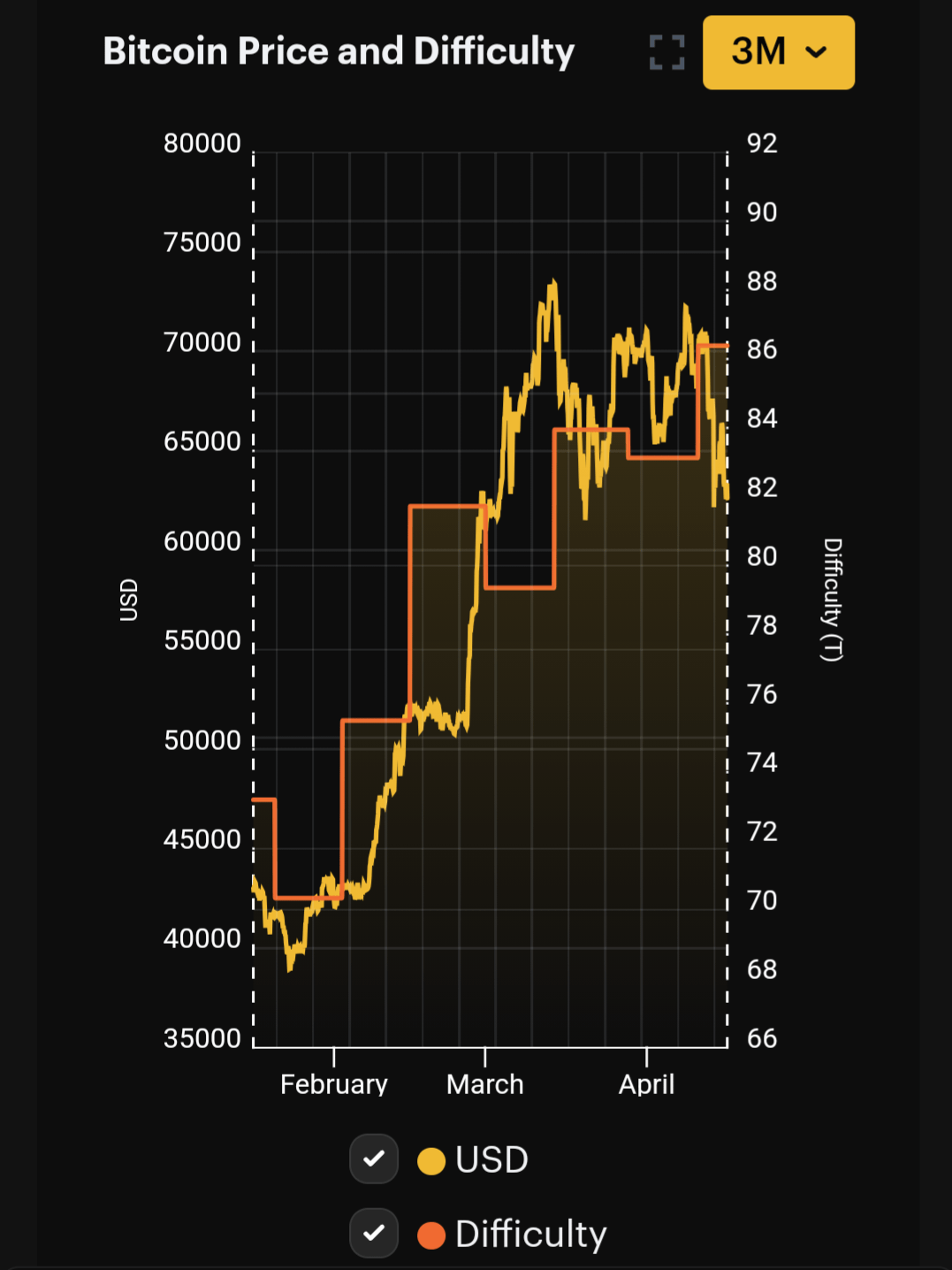
Bitcoin mining difficulty (hashrateindex.com)
CleanSpark’s strategic expansion decisions, coupled with timely execution, have begun yielding positive results. CleanSpark currently holds an impressive position among peers in terms of realized hashrate and fleet efficiency. CleanSpark mined 806 Bitcoin in March, a 24% increase over February’s production and a ~39 increase over January’s production – this, despite the steady increase in Bitcoin’s global hashrate and mining difficulty since the start of the year. Mining difficulty has increased by about 20% since the start of the year and now sits around 86 T. Difficulty is adjusted around every fourteen days based on the total hashrate, to maintain the Bitcoin block time. As the global hashrate and difficulty increase, coupled with the reduction in block reward, miners without efficient operations and high fleet efficiency may face significant challenges.
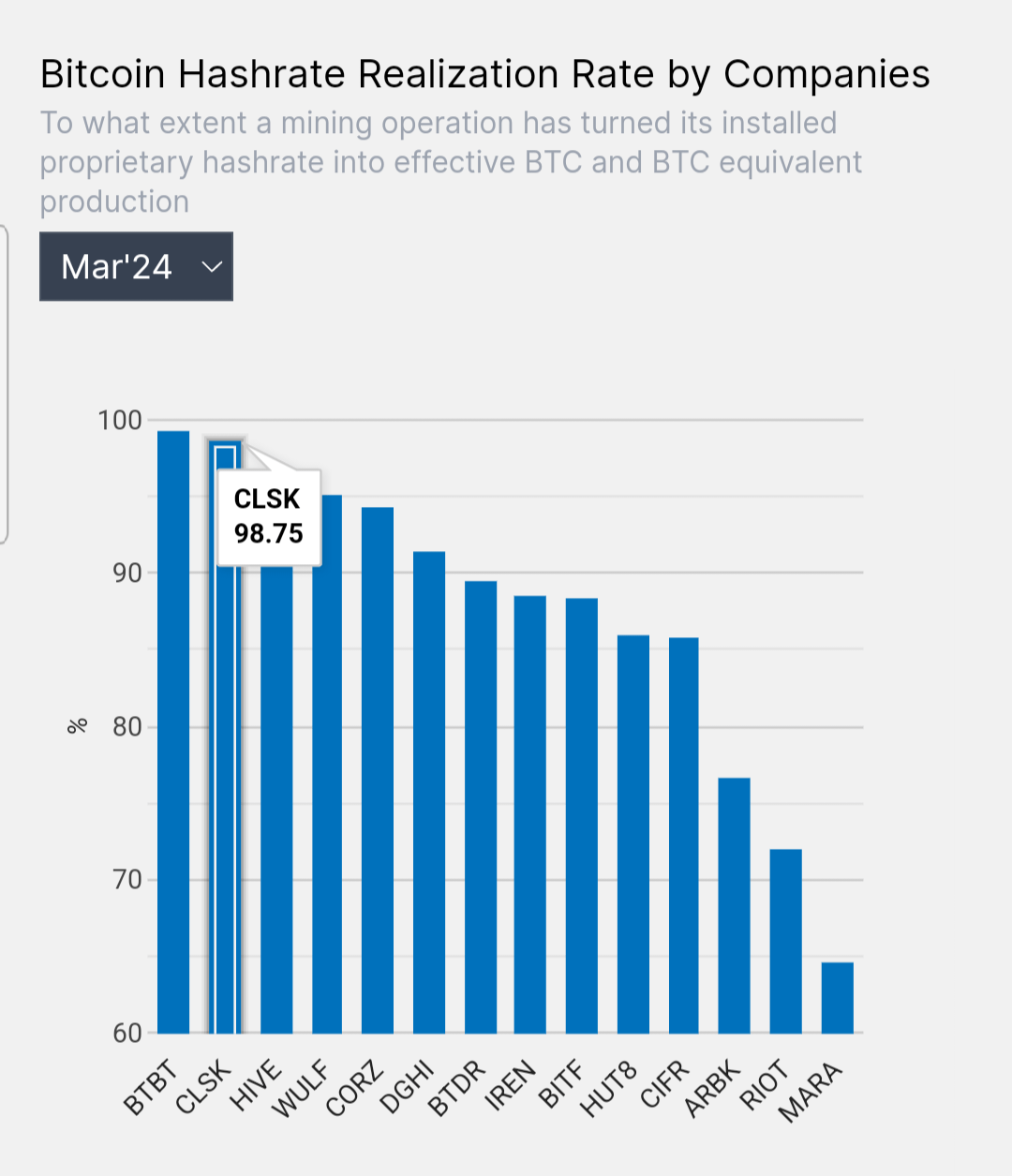
Miners’ hashrate realization rate (theminermag.com)
In October last year, CleanSpark flipped Riot Platforms (RIOT) in realized hashrate and currently stands only behind Marathon Digital (MARA) and Core Scientific (CORZ). CleanSpark boasts one of the most efficient fleets among peers, with an efficiency of 24.6 joules/terahash (J/TH), and one of the highest hashrate realization rate at 98.75%. The hashrate realization rate metric quantifies the extent to which a miner effectively utilizes its installed hashrate to produce Bitcoin.
CleanSpark’s planned addition of 100,000 more efficient S21 Pro miners, which operate at just 15 j/th, will potentially give CleanSpark an average fleet efficiency of ~19 J/TH, say the company maintains its current fleet in addition to the 100,000 S21 Pros. The new S21 Pro miners are slated to be added in the second half of 2024. I believe this timing will align favorably for the company, as the demand effects of the halving supply cut would have kicked in by then.
CleanSpark produced 7,391 total BTC in 2023, with the Bitcoin network seeing an average of ~50 T mining difficulty in 2023. In just Q1 this year and with a significantly higher Bitcoin network difficulty, CleanSpark already mined 2,031 BTC – about 28% of the total Bitcoin mined in 2023. These numbers underscore CleanSpark’s efficient operations.
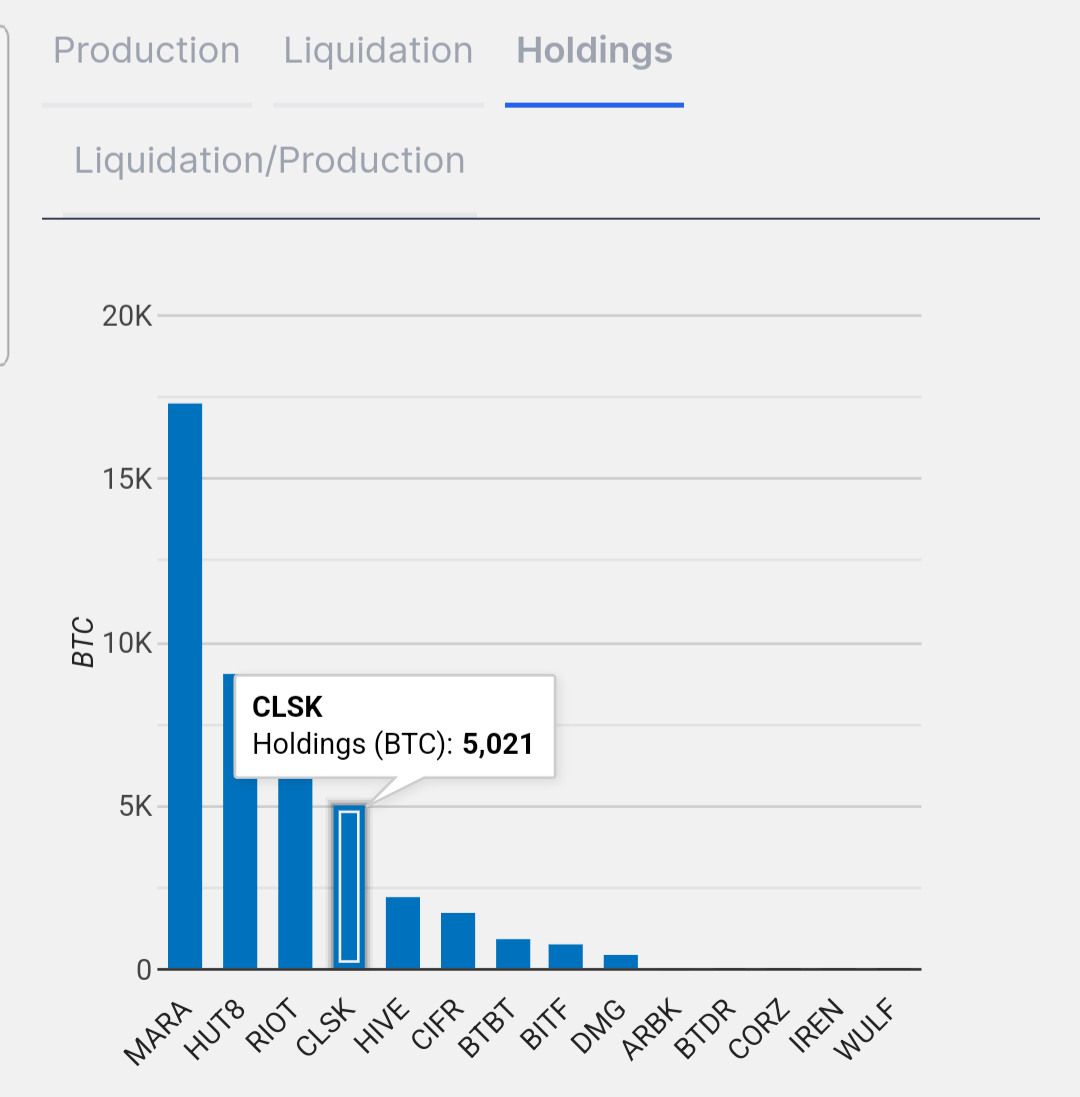
Miners’ Bitcoin stash (theminermag.com)
Opportunities come infrequently. When it rains gold, put out the bucket, not the thimble. – Warren Buffett
CleanSpark’s Bitcoin reserve has increased by about 67% in 2024, adding over 2,000 BTC to its Bitcoin holdings since the start of the year, and boosting the company’s cash position. CleanSpark now holds over 5,000 BTC, positioning it as the miner with the fourth-largest Bitcoin stash – behind MARA, Hut 8 (HUT), and RIOT. A management quality I’d consider for a Bitcoin mining company is its choice of financing at each point in the market cycle. Selling off Bitcoin stash to fund expansion efforts at this point in the cycle would likely turn out to be an awful decision that could lead to missing out on significant future unrealized profits.
Opting for debt financing also comes with lots of cons like high leverage and periodic interest payments which can constrain cash flow. Considering the crypto market’s time-sensitive, fast-paced, speculative, and unpredictable nature, these interest payments may occur at inconvenient times for the company, disrupting short-term plans. Defaulting on loans may also force the miner to liquidate its Bitcoin stash at an unfavorable market price.
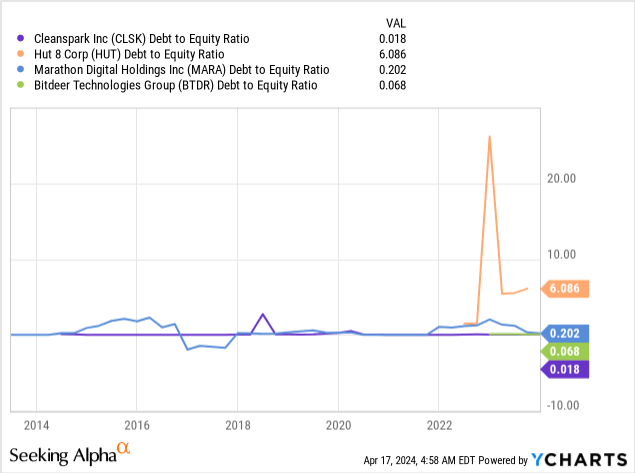
Though equity financing also comes with some known cons like the dilution of existing shareholders, I believe it is one of the best financing options for a Bitcoin miner at this point in the market cycle. In my view, The absence of periodic interest payments and the risk of defaulting on loans, which could result in forced liquidation of assets, makes equity financing more appealing for a Bitcoin miner. CleanSpark recently amended its initially announced $500 million at-the-market (ATM) offering with H.C. Wainwright & Co., to now issue another $800 million worth of its common stock.
I believe that the substantial amount that CleanSpark aims to raise reflects the scale of expansion plans underway. Furthermore, the post-halving period presents opportunities for M&As, with miners that face challenges in keeping up with reduced block rewards and increased network difficulty likely to be targeted for acquisition by peers with enough dry powder like CleanSpark.
One perk of CleanSpark’s equity financing is its low debt-to-equity (D/E) ratio. At 0.018 (D/E) ratio, CleanSpark has one of the lowest D/E ratios among the top Bitcoin miners, which translates to lower financial leverage.
Risks
As reiterated by a majority of analysts who cover mining stocks on Seeking Alpha, these stocks could be highly volatile as they are linked to the speculation and volatility of Bitcoin. For CLSK, there is the risk of shareholder dilution and also the risk of not adding shareholder value if Bitcoin doesn’t perform as expected and fails to meet CLSK’s cost of capital – the rate of return expected by investors for funding the company’s operations and investments.
Takeaway
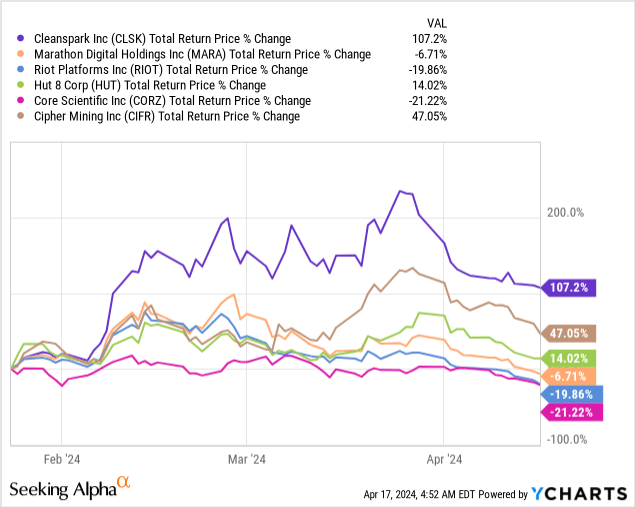
CLSK has seen impressive momentum YTD and has only seen its momentum stall recently, following the announcement of the additional $800 million ATM offering, coupled with Bitcoin’s recent volatility. The halving event is expected to create a supply shock, with the demand created by the spot Bitcoin ETFs potentially pushing prices higher. Given these factors, including CLSK’s plans for hashrate growth, its operational efficiency in mining, and the stock’s momentum YTD, CLSK is an attractive Bitcoin miner stock as we approach the imminent post-halving crypto bull market.
Analyst’s Disclosure: I/we have a beneficial long position in the shares of CLSK either through stock ownership, options, or other derivatives. I wrote this article myself, and it expresses my own opinions. I am not receiving compensation for it (other than from Seeking Alpha). I have no business relationship with any company whose stock is mentioned in this article.
Seeking Alpha’s Disclosure: Past performance is no guarantee of future results. No recommendation or advice is being given as to whether any investment is suitable for a particular investor. Any views or opinions expressed above may not reflect those of Seeking Alpha as a whole. Seeking Alpha is not a licensed securities dealer, broker or US investment adviser or investment bank. Our analysts are third party authors that include both professional investors and individual investors who may not be licensed or certified by any institute or regulatory body.
